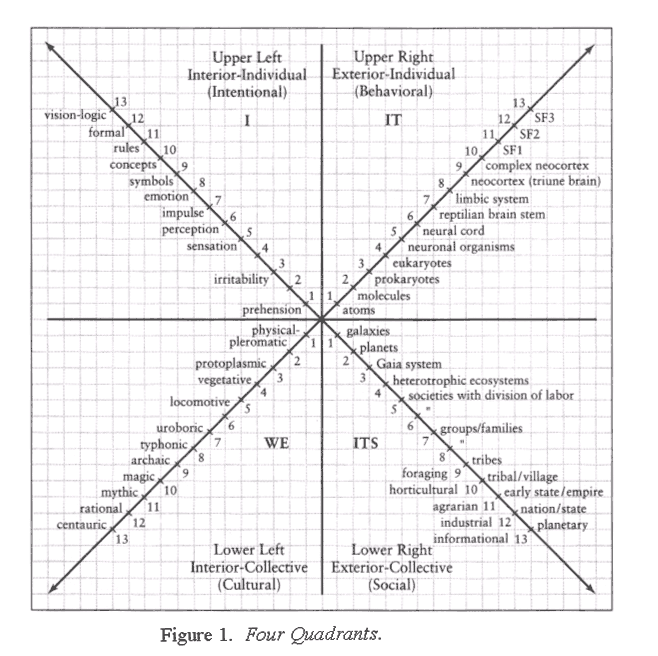understanding Integral theory

in this program

i sought a world philosophy — or an integral philosophy — that would believably weave together the many pluralistic contexts of science, morals, aesthetics, Eastern as well as Western philosophy, and the world's great wisdom traditions. not on the level of details — that is finitely impossible; but on the level of orienting generalizations: a way to suggest that the world really is one, undivided, whole, and related to itself in every way: a holistic philosophy for a holistic Kosmos, a plausible Theory of Everything.

Ken Wilber

welcome to the Integral section on unsui. Integral is a meta-theory (a theory about theories) that aims to provide a comprehensive roadmap of the Kosmos. in other words, it is a theory about everything. it was assimilated by Ken Wilber, a prolific scholar and writer who seems to have read pretty much everything, and who has also studied and practiced just about all of the contemplative traditions in some depth. all-in-all, a pretty impressive effort from a pretty impressive guy. unsui has been deeply influenced by Integral, and in many ways, it aims to be an Integral endeavor. you will see what we mean by this as we work through the model.
there are already several books and summaries on Integral available (most notably those by Wilber himself), and we will link to some of them throughout. we will, therefore, provide only brief outlines of Integral theory, Integral mindfulness, Integral psychology, and Integral spirituality, so that you can orient yourself to the theory/perspective, and to the applications of it that are most relevant to unsui. Integral theory has thus far been applied to almost every human endeavor, including politics, medicine, business, law, and leadership, and many of these can be further explored on www.integrallife.com.

“integrative” simply means that this approach attempts to include as many important truths from as many disciplines as possible— from East as well as West, from premodern and modern and postmodern, from the hard sciences of physics to the tender sciences of spirituality.

Ken Wilber

initial orienting principles
as stated, Integral is a metatheory. in other words, it is a theory about theories; a theory that includes, combines, and contextualizes other theories within a metatheoretical model.
Integral aims to be a comprehensive theory of the Kosmos, while at the same time acknowledging that “the map is not the territory”, meaning that any theory or model is, by its nature, reductive. it can never fully capture all the subtleties and nuances of life, just like no useful map of New York could ever include every single aspect and detail of it.

AQAL [see later] is a map of samsara, a map of the prison, but if you’re gonna make a prison break, you need a good map.

Ken Wilber

Integral theory is based on the premise that “everybody is right”, or “all perspectives are true but partial, including this one”. this means that every perspective has some truth to it, but no single perspective has a monopoly on all truth for all people at all times. if your mind has just done something like “what?! are you saying those (liberals/ conservatives/ wokesters/ boomers, etc) are right?!” then remember, we are saying “true but partial”. the full integration of the realization that “my own perspective is partial” necessarily means that, by implication, other perspectives may have bits of truth that i don’t (yet) have access to.

an Integral approach is based on one basic idea: no human mind can be 100% wrong. or, we can say, nobody is smart enough to be wrong all the time. and that means, when it comes to deciding which approaches, methodologies, epistemologies, or ways of knowing are “correct,” the answer can only be, “all of them.”

Ken Wilber

Integral is a developmental model, that is, it posits that all of manifest reality is constantly evolving towards greater complexity and wholeness. of course, this evolution does not always produce optimal results (from the relative perspective), and when things go wrong, we experience difficulties, in both the individual and collective dimensions, on the inside and/or the outside.
Integral can help us to grow and heal on both the individual and collective dimensions, and on the inside and the outside. we will focus on growth and healing in the individual interior.
core principles
the heart of Integral is the AQAL (All Quadrant All Level) model. the best way to introduce AQAL is with the following diagram:

as you can see, the model consists of four quadrants. the quadrants represent both the four dimensions of reality, and the four perspectives that we can take when understanding any issue or aspect of reality. the left-hand quadrants represent the interior dimensions of reality, and the right-hand quadrants represent the exterior dimensions. additionally, the top quadrants represent the individual dimensions of reality, and the bottom quadrants represent the collective dimensions. so, we can either look at reality from the individual or the collective perspective, and we can either take an inside or an outside view. this yields four irreducible perspectives: the upper left (“i”) which is subjective or intentional; the lower left (“we”) which is intersubjective or cultural; the upper right (“it”) which is objective or behavioural; and the lower right (“its”) which is interobjective or social. the quadrant perspectives are irreducible because each has to be understood within its own dimension. none of them can be used to adequately understand any the others. for example, we cannot use psychology (upper left), or systems theory (lower right), or anthropology (lower left) to understand brain states and neurochemicals (upper right). for that, we have to employ upper right methodologies: empiricism, biology, and chemistry. and these upper right methodologies would be of little use in studying politics (lower right), or existentialism (upper left), or religion (lower left).
the four quadrants tetra-arise, that is, they arise together. none of them cause any of the others, and no quadrant is more fundamental than any of the others. they simply arise simultaneously as the four dimensions of reality.
the four quadrants correlate to the three value spheres of subjectivity (upper left), intersubjectivity (lower left), and objectivity (upper right and lower right), as well as to the Big Three: the three perspectives found in every language on Earth, namely first person (“i”— upper left), second person (“we”— lower left) and third person (“it/its”—upper right/lower right). they also relate to the three transcendentals, namely the Good (morals, related to the lower left), the True (science, related to the upper right and lower right), and the Beautiful (art, related to the upper left).
an inclusive approach to understanding any issue or aspect of reality has to include all four quadrants, or in other words, all of the Big Three. for example, we have all heard debates about what causes complex phenomena like poverty, where learned intelligent people fight tooth and nail, saying things like “it’s not about corporate greed, it’s about individual responsibility!” or “it’s not about social welfare, it’s about the stability of the nuclear family!” from an integral perspective, it’s about all these things, and a whole lot more. for any impoverished individual or group, there may be individual interior (e.g. psychological) reasons, individual exterior (e.g. disability) reasons, collective interior (e.g. cultural) reasons, and collective exterior (e.g. social) reasons that co-create their dilemma. and if any of the quadrants are ignored, or, as happens more commonly, if any of the quadrants are reduced to or collapsed into the other quadrants, resulting in what Wilber calls flatland, any interventions or attempts to improve the situation will be, at best, partially effective, and at worst, dismal failures that exacerbate the problems they attempt to solve.

if you really want to change the world, you must first understand it adequately, or all you will do is reproduce in larger numbers your own ignorance.

Ken Wilber

a common example of flatland is the claim that our phenomenological (felt-lived) experience is simply a by-product of the physical activity of our brains. as we have seen, 1) if we use the perspective of one quadrant to try to understand the dimension of another quadrant, we end up in a confused mess, and 2) the quadrants tetra-arise. hence, according to Integral, brain states are the neurological (upper right) correlates or our phenomenological experience (upper left). there is no need for reductionism or cynicism. your love for your child is not simply the result of oxytocin flooding your bloodstream. rather, oxytocin is an upper right correlate of the upper left felt experience of closeness and intimacy. this neither reduces the meaning we ascribe to love, nor the value of the scientific lens. so no, we can’t just eat loads of chocolate or spray oxytocin into our nostrils daily rather than have meaningful relationships and expect to feel like we have a full life. nor can we expect to be totally unaffected psychologically by sickness or advancing age. nor can we expect to live in a pathological culture and be totally socially integrated and happy. and nor can we live in a broken society and expect to reach our full potential in the political and economic realms. according to the Integral view, if we truly want to create a life — and a world — that is better than the one we currently have, we need to pay attention to all its facets. so, what are these?
AQAL, besides being an acronym, is also shorthand for: all quadrants, all levels, all lines, all states, and all types. let’s take these in turn:
quadrants: we have just given a summary of the quadrants. they are the four dimensions of all of reality, and they tetra-arise, meaning phenomena arise in all four quadrants simultaneously. for example, my phenomenological experience of reading these words (upper left quadrant) is arising simultaneously with my neurons firing (upper right quadrant), and this is all happening in — and being influenced by — my cultural (lower left quadrant) and social (lower right quadrant) context. the quadrants are also the four fundamental perspectives of reality that we need to include to have a comprehensive view of any issue or facet of reality.
levels: levels refers to levels of development. the diagonal lines on the diagram with the arrows pointing outwards represent the levels of development.
as has already been stated, Integral is a developmental theory. it posits that the universe, including human consciousness, is constantly unfolding into greater complexity, wholeness, and integration. the process through which this occurs is one of “transcend and include.” for example, atoms bond together to form molecules, which bond together to form cells, which bond together to form multicellular organisms… all the way to the human brain, which is the most complex living structure we are aware of (the one that can express consciousness most fully). molecules include atoms; they don’t repress them or force them together, they include them in a wider embrace. molecules also transcend atoms, that is, no single atom can do what a molecule can do; the atom is less complex than the molecule, and therefore less capable of expressing consciousness. the saying “the whole is more than the sum of its parts” relates to this principle.
each quadrant manifests the levels in the forms that fit within its dimension, and the quadrants all evolve together, simultaneously. this is known as tetra-evolution. the example above describes the upper right version: atoms to molecules to cells to simple multicellular organisms… all the way to the complex neocortex. in the upper left quadrant, prehension (basic grasping or seizing) evolves to irritability (the ability to be sparked into action by an external stimulus), which evolves into sensation, and perception… and all the way to complex and nuanced forms of logic. the same goes for the lower quadrants. so, in general terms, we have developmental lines that apply to our psychology and sense-making abilities, to our bodies and brains, to culture, and to society, and these are all interrelated. if you draw a series of concentric circles in the diagram above, you will see the interrelationships between the levels within the quadrants. for example, if you draw a circle that links points 9, you will see that symbolic thought (UL) correlates with a neocortex (UR) on the individual level, and on the collective level, with the archaic worldview (LL), which is seen in foraging tribes (LR).
with increasing complexity also comes increasing potential problems. atoms can’t get cancer, nor can molecules or amoebas, but lizards can. lizards don’t get depressed, but dogs can (maybe not in the same way as we do, but it’s clear that non-human mammals can and do experience some forms of mental illness), and dogs don’t have existential crises, but humans do. this is all to say that development is not straightforward process that always results in the desired outcome of greater wholeness and integration. development can go wrong, and the way it usually goes wrong is that, instead of transcendence and inclusion, there is repression and stagnation or regression. furthermore, the more complex an individual or system, the more there is that can go wrong (hence the myriad of problems that humans face, be they physical, psychological, social, cultural, spiritual, political, financial, existential, etc. etc. etc.)

each stage of development, remember, has a dialectic of progress— in plain language, every new development is good news, bad news.

Ken Wilber

we will focus on individual psychospiritual development (upper left quadrant). Integral recognizes and includes several models of this kind of development or maturation. the most basic of these outline development as unfolding from pre-conventional to conventional to post-conventional, or egocentric to ethnocentric to worldcentric to Kosmocentric. these basic levels or stages can be further differentiated, yielding multi-level models. we will explore these in greater detail throughout the Integral section, and you can also refer to our programs on maturing in the mindfulness section.
lines: lines refer to lines of development, in other words, all of the different distinct capacities that make up our overall functioning. the most well-known lines of development are the cognitive (roughly correlating to IQ) and emotional intelligence (EQ) lines. those familiar with multiple intelligence theories like Howard Gardener’s may also have heard of musical intelligence, body-kinesthetic intelligence, and interpersonal intelligence, among others. Integral recognizes over 100 lines of development, the most fundamental of which are cognitive, interpersonal, psychosexual, emotional, and moral. development is not a single road. in fact, the norm for any given individual is to be at different levels of development in the different lines.
a general rule with lines of development is that the cognitive line is necessary but not sufficient for growth in the other lines. there is unfortunately no way around it, cognitive development sets the ceiling on all-round development. at the same time, no amount of cognitive development will guarantee any development in other areas, unless the person pays particular attention to developing these areas. we will explore lines more deeply in the Integral psychology and Integral spirituality sections.

human beings have a variety of intelligences, such as cognitive intelligence, emotional intelligence, musical intelligence, kinesthetic intelligence, and so on. most people excel in one or two of these, but do poorly in the others. this is not necessarily or even usually a bad thing; part of Integral wisdom is finding where one excels and thus where one can best offer the world one’s deepest gifts.

Ken Wilber

states: states refers to states of consciousness. the most fundamental categorization distinguishes three states, namely waking, dreaming, and deep sleep. these states are the basis of any spiritual tradition that includes state practices. the three primary states can be further differentiated. for example, in the waking state we can experience states like sober, drunk, alert, somnolent, energized, distractible, dreamy, etc. states are exclusive, meaning we can only experience one state at a time. you can’t be drunk and sober at the same time, nor can you be objectively awake and asleep at the same time. we will explore states more deeply in the Integral Spirituality section.
types: types are categories of people or things that have common characteristics. the most basic type distinction in Integral is that of masculine and feminine: the two fundamental, distinct, interdependent, different-but-equal flavors of consciousness. they represent night and day, yin and yang, agency and communion, upward and outward. a more nuanced level of typology would be personality types, as delineated in, for example, the Enneagram, about which you will find lots of information in our personality programs under the mindfulness section.

to understand the whole it is necessary to understand the parts. to understand the parts, it is necessary to understand the whole. such is the circle of understanding.

Ken Wilber

so, in order to understand reality in a comprehensive — or Integral — way, we have to pay attention to all quadrants, all levels, all lines, all states, and all types. these are the fundamental facets of reality that we have to include in our worldview if we are to move towards growth, healing, and wholeness. even a quick overview of the Integral model reveals the breadth and depth of its scope, and it is easy to get caught up in the intellectual side of things. indeed, Wilber has stated that one of the biggest challenges of Integral is the assumption that if we understand it intellectually, then we “are Integral.” he emphasizes that intellectual understanding is only the tip of the iceberg, and it is only when the knowledge becomes embodied — when we can “walk our talk” — that we are really utilizing an Integral approach.
in the following programs we’ll look at some of the applications of the Integral model, and how it can expand our awareness in these particular fields.

but the real intent of my writing is not to say, “you must think in this way”. the real intent is to enrich: “here are some of the many important facets of this extraordinary Kosmos; have you thought of including them in your worldview?” my work is an attempt to make room in the Kosmos for all the dimensions, levels, domains, waves, memes, modes, individuals, cultures, and so on ad infinitum.

Ken Wilber


